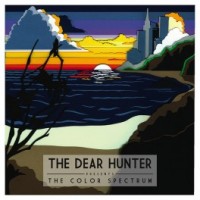This story first appeared in Chromatic: The Crossroads of Color and Music. Order your copy today.
 The Dear Hunter: The Color Spectrum (Triple Crown, 6/14/11)
The Dear Hunter: The Color Spectrum (Triple Crown, 6/14/11)
The Dear Hunter: “Deny It All”
[audio:https://alarm-magazine.com/wp-content/uploads/2011/06/The_Dear_Hunter_Deny_It_All.mp3|titles=The Dear Hunter: “Deny It All”]Ambition is a funny thing. Calling someone ambitious can be made to sound skeptical, or dismissive, or snide, but it also can be used to describe work that harnesses exceptional effort and ability to achieve remarkable ends. For The Dear Hunter, the theatrical, prog-pop project of Casey Crescenzo, these ends include producing multiple multi-album concept cycles as well as reconsidering the way that the music industry promotes its musicians and engages its fans.
The Dear Hunter began as a side project for Crescenzo, formerly of post-hardcore group The Receiving End of Sirens, and blossomed into a band, a character, and now a fan club. It was intended for the progressive rock concepts that didn’t fit The Receiving End of Sirens’ sound, but it quickly transformed into a full-time endeavor, using a six-act story arc to explore the life of a child born at the turn of the 20th Century who becomes a combatant in World War I.
“When I first thought of doing it,” Crescenzo says, “it didn’t need to be in a realistic band setting, so I was free to make it really ambitious. I didn’t think I’d have to back it up by playing it live; I could do it in my free time, not concentrating on touring or selling. The first demos I did of it, I made ten copies and gave them to close friends and the other band members. They passed them on to friends, and they were posted online and people started downloading them.”
In September of 2006, Crescenzo released Act I: The Lake South, The River North, the introduction to the series and the story of The Dear Hunter’s birth and childhood with his mother. It was essentially a solo project, though Crescenzo enlisted the help of his family: his mother sang, his father played organ, and his brother Nick drummed. “I had relationships troubles — extreme relationship problems,” Crescenzo notes. “And instead of writing about myself, instead of writing songs that were kind of complaining, I wanted to write a story.” In 2007, he released Act II: The Meaning of, and All Things Regarding Ms. Leading, which tells the story of The Dear Hunter’s doomed love for a prostitute. In the summer of 2009 came Act III: Life and Death, about The Dear Hunter’s life in the trenches of World War I. Both albums were massive, bombastic, dense, outsized, and outstanding.
Following the third act, however, Crescenzo announced the band’s intention to put Act IV on hold indefinitely. Instead, the group shifted gears to tackle another aspiration of large scale — the nine-EP Color Spectrum project, released in 2011, that is inspired by the colors of the rainbow (red, orange, yellow, green, blue, indigo, and violet) plus black and white. On its own, it’s an ambitious project, made audacious when one considers that The Color Spectrum is only a palette cleanser between installments of the original six-album series concerning the birth, childhood, manhood, and death of its titular protagonist. Yet whereas The Dear Hunter has a fairly contained story arc, The Color Spectrum is wide open.
“Anything we think of, we can do,” Crescenzo says. “Humanity’s idea of colors is too broad. This needs to me be more personal, because ideas of colors vary from person to person. Even for people who have synesthesia, the specific images or sounds they hear attached to colors vary from person to person. And that just reinforces the point of doing the project, to produce our interpretation of color, the way we feel about colors or are inspired by the colors — how we hear them or see them.”
The unfinished material from the The Color Spectrum project is as assorted as its inspirations. Black is sonorous, martial, deep, and reverberating but also playful, confident, and determined. White is ethereal and hymn-like in places, but also doggedly cheerful like a self-help seminar. Blue is playful, youthful, and driven, churning and giddy; Green is ebullient, relaxed, and expansive; Red is sexy and insinuating as well as aggressive.
None is particularly obvious. It’s easy to imagine an album based around colors and their pat emotional pairings — red is angry, blue is calm — but these tracks only use those familiar associations as jumping-off points to explorations of greater complexity. Tonally, too, many of the tracks start off focused, driven, and narrowly rhythmic before opening into an expanded sense of space and possibility. There is room for the unexpected.
In addition to reconsidering the perception of color, The Dear Hunter is rethinking the traditional music industry model. “We need to stop thinking so linearly about the way that we do things,” Crescenzo says. “We have established a boutique kind of identity, and we have a group of very dedicated fans. We are not focused on selling as many albums as we can, but [rather] on depth, and on offering our fans something unique.” One of the band’s initiatives is a 250-person, limited-edition fan-club package. For $125, a fan gets lifetime seats to The Dear Hunter concerts plus extras like vinyl boxed sets and a hand-written note from the band. “It sold out in three days,” Crescenzo says. “[It] gave us the confidence to do the color projects and self-release them.”
Judging by past their past enthusiasm, fans of The Dear Hunter will anxiously await the band’s take on the color spectrum. If colors are, as Crescenzo says, perceived differently by every person, his band’s interpretations will merely be the beginning of an extended conversation. It’s an ambitious undertaking, but one that feels natural and attainable for the band. After all, The Dear Hunter isn’t just making music about color; it’s coloring the way that music is made.



